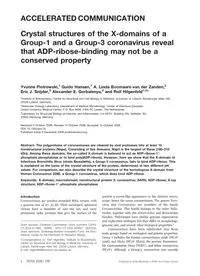
2009 Crystal structures of the X-domains of a Group-1 and a Group-3 coronavirus reveal that ADP-ribose-binding may not b PDF
Preview 2009 Crystal structures of the X-domains of a Group-1 and a Group-3 coronavirus reveal that ADP-ribose-binding may not b
ACCELERATED COMMUNICATION Crystal structures of the X-domains of a Group-1 and a Group-3 coronavirus reveal that ADP-ribose-binding may not be a conserved property Yvonne Piotrowski,1 Guido Hansen,1 A. Linda Boomaars-van der Zanden,2 Eric J. Snijder,2 Alexander E. Gorbalenya,2 and Rolf Hilgenfeld1,3* 1Institute of Biochemistry, Center for Structural and Cell Biology in Medicine, University of Lu¨ beck, Ratzeburger Allee 160, 23538 Lu¨ beck, Germany 2Molecular Virology Laboratory, Department of Medical Microbiology, Center of Infectious Diseases, Leiden University Medical Center, P.O. Box 9600, 2300 RC Leiden, The Netherlands 3Laboratory for Structural Biology of Infection and Inflammation, c/o DESY, Building 22a, Notkestr. 85, 22603 Hamburg, Germany Received 2 October 2008; Revised 14 October 2008; Accepted 15 October 2008 DOI: 10.1002/pro.15 Published online 2 December 2008 proteinscience.org Abstract: The polyproteins of coronaviruses are cleaved by viral proteases into at least 15 nonstructural proteins (Nsps). Consisting of five domains, Nsp3 is the largest of these (180–210 kDa). Among these domains, the so-called X-domain is believed to act as ADP-ribose-100- phosphate phosphatase or to bind poly(ADP-ribose). However, here we show that the X-domain of Infectious Bronchitis Virus (strain Beaudette), a Group-3 coronavirus, fails to bind ADP-ribose. This is explained on the basis of the crystal structure of the protein, determined at two different pH values. For comparison, we also describe the crystal structure of the homologous X-domain from Human Coronavirus 229E, a Group-1 coronavirus, which does bind ADP-ribose. Keywords: X-domain; macrodomain; nonstructural protein 3; coronavirus; SARS; ADP-ribose; X-ray structure; ADP-ribose-100-phosphate phosphatase Introduction Coronaviruses are positive-stranded RNA viruses with a genome size of 27–32 kb. Their enveloped, spherical virions have a diameter of 100–160 nm and carry prominent spike proteins that give the surface of the particle a crown-like appearance in the electron micro- scope, hence the name coronaviruses. The genera Toro- virus and Coronavirus are members of the family Coronaviridae. This family belongs to the order Nido- virales, together with the Arterivirdae and Roniviridae families. Nidoviruses have similar genome organization and replication strategies but they differ in morphology, genome size, and several other biological properties.1 Coronaviruses have been subdivided into three main groups based on serological and genetic properties. Group 1 includes the human coronaviruses 229E (HCoV 229E) and NL63 (HCoV NL63), the porcine Transmissi- ble Gastroenteritis Virus (TGEV), and feline coronavirus (FCoV). Although a Group-3 coronavirus was recently Grant sponsor: European Commission; Grant numbers: LSHG- CT-2004-511960 VIZIER, SP22-CT-2004-003831 SEPSDA; Grant sponsors: Schleswig-Holstein Innovation Fund; the Sino- German Center for the Promotion of Research, Beijing. *Correspondence to: Rolf Hilgenfeld, Institute of Biochemistry, Center for Structural and Cell Biology in Medicine, University of Lu¨ beck, Ratzeburger Allee 160, 23538 Lu¨ beck, Germany. E-mail:
